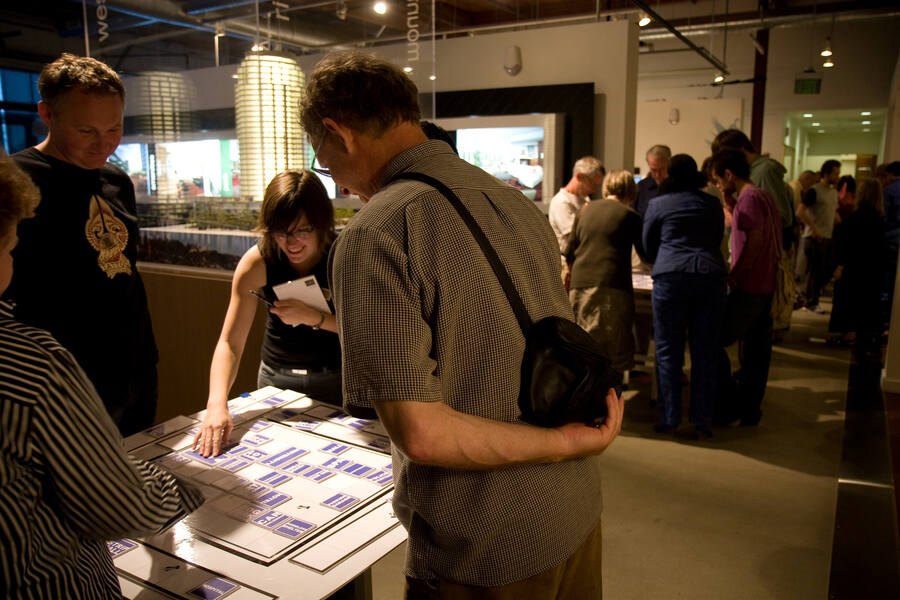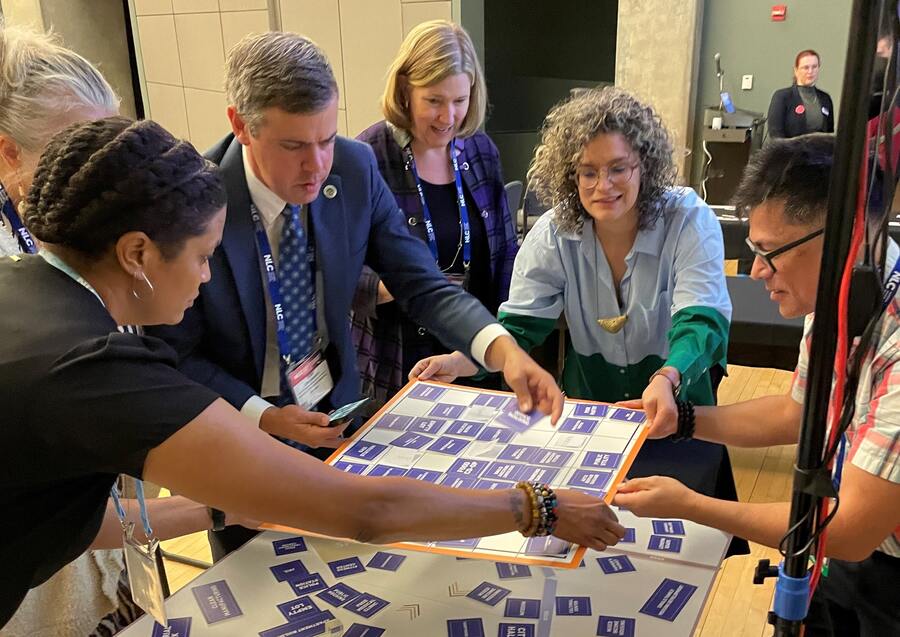At this moment theatres are discussing, discovering, debating, and delivering upon the roles they are called to take on in community.
Storytelling. Transformational engagement. Shared resources. Statements of solidarity and actions in service to movements. There is no single way to be a theatre in one’s place now. There never has been.
But because so much seems to hang in the balance—every day, so much seems to hang in the balance—the activity and the business of making theatre, building audiences, and demonstrating the value of our work has perhaps never seemed more urgent, and has never been more complex.
I’d like to add another possibility to the mix.
I’d like to suggest that in addition to the stories we tell and the spaces we hold, there is a particular service that our communities need, and it matches up pretty well with skills we possess.
In many spaces today, people don’t know how to be together.
We don’t know how to talk to each other.
We don’t know how to listen and we don’t know how to work things out.
Our democracy is struggling partly because of the ways many of our leaders weaponize hate and mistrust, but also because most of us don’t have the muscles needed to work through difficult conversations and imagine possibility.
Theatre is made up of individuals who create opportunities for empathy.
Theatre is, as many have said, an empathy gym.
But maybe empathy isn’t enough.
Maybe we could offer more than scripts that tell us what we don’t know, or haven’t felt.
Maybe we could offer scores to help us practice what comes after empathy—to help us take our empathy and move it out beyond ourselves.
What if artists made civic scores, and theatres produced them not just in theatre buildings but offered them up anywhere, gave them away, to anyone trying to build dialogue and imagine futures together?
Demonstrating our imagination onstage is a powerful act…
But what if we offered our communities creative tools to practice their own imaginations in contexts where democracy is failing us?
What if we were to equip public gatherings to be gymnasiums for civic imagination?
Civic Score # 37: Public Meeting
For people who have convened/been convened about something as part of an ongoing set of formal meetings, as part of a bureaucratic process, or for the first time.
Sit in a circle of chairs.
See each other.
Take a breath, together.
(There is music.)
Introduce yourself. In pairs. Then quartets.
Then as a whole circle, one by one.
No introduction should be longer than 15 seconds
(Music out.)
See each other.
Commit publicly,
Call and response:
For the duration of this time together
We commit
to the act of presence,
the intention of listening,
to the pursuit of curiosity and generosity,
and to care.
Say that out loud.
Choose two people to keep one eye on adherence to these commitments and empower them to raise a hand and ask a question if they have an observation about these commitments and their practice at any moment.
Someone speak the reason for the gathering in under 60 seconds.
Anyone: Speak concerns about what this gathering might reveal or touch.
Spend 10 minutes speaking and listening; make certain in this time all who wish to speak can and do.
(There is music.)
Choose someone who has spoken little so far to summarize what they have heard up until this point in one to three minutes.
No one will judge the quality of their summary nor add to it.
(Music out.)
Three people speak for 30 seconds each on ways it is hard to live together these days.
Three people speak for 30 seconds on why it is worth trying to live together these days.
With the first partner you paired with for introductions, spend 10 minutes discussing what the worst version and the best version of this gathering might look like, including what might come of it.
Then…
(There is music and no speaking for two minutes.)
Now within the whole group, someone offer a story from their life that has come up for them as a result of this gathering so far. Share it in three to five minutes.
Three other people each get two minutes to share a story that has been brought to their minds.
Five people will finish a sentence that begins with the words: “At this point, I think…”
Someone will sing a song.
Someone will remember aloud something from at least 100 years ago and will do so in less than two minutes.
Pieces of paper will be handed out, and people will write what they think should happen next in three-to-seven words.
The pieces will be crumpled and tossed into the middle of the circle of chairs.
Everyone will retrieve a piece of crumpled paper.
Everyone will read their piece of paper to themselves, and then pass it around the circle, until everyone has read at least 10 pieces of paper to themselves.
Let this passing happen with a rhythm.
(There is music.)
Anyone can stand and say one thing they think could happen next, and it cannot be what they wrote on their paper.
Someone will say something that has not been said and should be said.
Someone will express gratitude.
Everyone will, one by one, say goodbye to whoever they introduced themselves to at the beginning and then take their seats.
Someone will end the formal part of the meeting
(There is food. Music continues.)
People stay and talk for at least 20 more minutes.

Imagine the Possibilities
That was just one example, but the possibilities are as endless and as varied as artists’ voices and inclinations. Writers can write civic scores. Dramaturgs can assemble/compose/construct them. Directors can stage them. Teaching artists can lead them. Composers can score the scores. Designers can shape space and presence. Producers can find opportunities and resources. Marketing can seek events already happening and drive people to them, or engagement departments can host events in and around community.
Civic Scores can be produced to be witnessed; they can be led as structured group improvisations; they can be seen as a set of stage directions to be performed or as a set of instructions to be followed. They can be led by artists or given as blueprints for civic gatherings.
Artists and organizations could identify and invite stakeholders, neighbors and peers, people and groups, to consider partnering on civic events that feel one part artistic practice, and one part—perhaps more than one part—civic practice.
Schools can be partners and workshop scores in class; places of worship can come together to try a score over fellowship or across faiths; the local arts council can host one for city employees; the health department can use one as a public engagement strategy.
Civic Scores are not new. There is a line (not a straight one) that connects John Cage’s scores to John O’Neal’s story circles; that connects fluxus to neofuturism to Spolin; that connects Alan Kaprow’s happenings to Augusto Boal’s Theatre of the Oppressed; that connects social justice ensembles begun in the 1960s and ’70s (El Teatro Campesino, San Francisco Mime Troupe, the Road Company, Junebug Productions, Roadside Theater) to experimental artists from then to now (Living Theatre, Mabou Mines, Sekou Sundiata, 600 Highwaymen, Daniel Alexander Jones, Daniel Bernard Roumain, Liz Lerman, Aaron Landsman, Sojourn Theatre, Mark-n-Sparks). Many of us have been exploring instruction-based dramaturgy for decades, and some of our work lands as performance at theatres, presenting houses, and festivals like Mixed Blood, Cleveland Public Theatre, and Under the Radar. Some of it appears as creative facilitation in community development contexts like United Way, Public Health departments, Catholic Charities USA, and city planning departments.
When we invite audiences to choose and participate, when we explore agency and discovery, we are, in our different rooms and with our different audiences, asking people to reconsider attention, generosity, the unknown, and ultimately co-creation. At its most aspirational, democracy demands each of these qualities. What if we were to turn our abilities, our artistic inclinations, and our energy to building capacity for these qualities in and with our communities now, right now?
Michael Rohd’s recent/upcoming civic scores include work with Santa Clara County Public Health Department (CA), Montana Repertory Theater/Montana Healthcare Foundation (MT), More Perfect Union (national veteran-led civic dialogue organization), and Long Wharf Theater’s 2024 Artistic Congress. Rohd (Sojourn Theatre, Center for Performance and Civic Practice, Co-lab for Civic Imagination at University of Montana) is a theatremaker, process designer and facilitator with a 30-plus year history of projects across sectors bringing cultural activity to the work of public engagement, community planning, and coalition building. www.michaelrohd.com.


